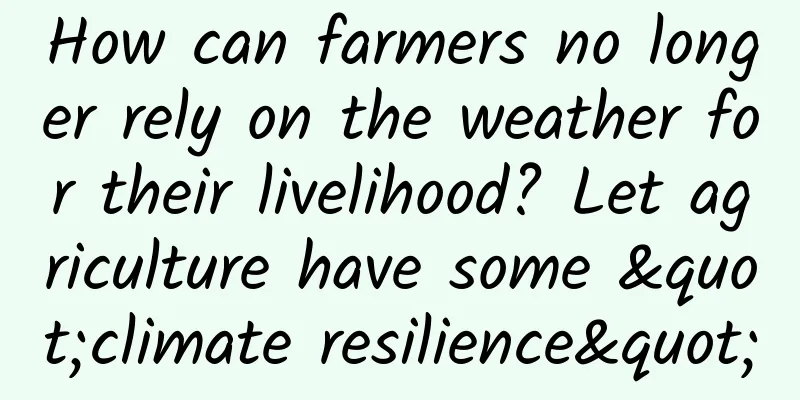How can farmers no longer rely on the weather for their livelihood? Let agriculture have some "climate resilience"

|
Super typhoons have frequently landed this year. "Dusurui" alone brought strong winds and rainstorms to more than ten provinces in the country, causing serious losses. Agriculture, which "depends on the weather for its livelihood", is undoubtedly the hardest hit area. Harbin, Heilongjiang Province under the influence of "Dusuri" Photo provided by Wang Yumei According to records, China is one of the countries most affected by extreme weather events related to climate change. Drought is the disaster with the greatest impact on China's agriculture, followed by floods and wind and hail disasters. With future climate change, extreme weather will occur more frequently, causing changes in temperature and precipitation patterns, which will directly or indirectly cause a reduction in grain production. Some experts predict that by 2030, seasonal droughts could cause an 8% reduction in the production of China's three major staple crops (rice, wheat and corn), seriously affecting food security. The agricultural system is highly dependent on the natural environment. Although farmers have continuously adapted to environmental changes during production, the increasingly severe climate crisis over the past 50 years has brought unprecedented challenges to food production and seriously threatened farmers' livelihoods. Total agricultural economic losses due to disasters in 22 reporting countries. © United Nations Office for Disaster Risk Reduction How to resist threats ? ——Developing climate-resilient agriculture Climate-resilient agriculture is a method of improving the long-term productivity of agricultural production systems and farmers' incomes by sustainably utilizing existing natural resources in the context of intensified climate change. It aims to improve the resilience of agricultural production systems that are highly exposed and vulnerable to climate change, that is, to reduce the risks and losses caused by climate disasters and have the ability to quickly return to a stable state. Simply put, it means reducing the reliance on the weather for agriculture. In 2022, the Ministry of Ecology and Environment and other ministries and commissions jointly issued the "National Climate Change Adaptation Strategy 2035", pointing out that "mitigation and adaptation are the two major strategies for addressing climate change. In addition to reducing emissions and fixing carbon, agriculture must also focus on enhancing its adaptability and improving its "resilience" to various adverse climatic conditions. Driven by modern scientific and technological innovation and structural transformation, we advocate the development of ecological, green and renewable agriculture, sustainable animal husbandry, blue aquaculture, and climate-smart agriculture. These nature-based production solutions and the enhancement of resilient agriculture to cope with vulnerability, shocks and pressures will become an important direction for global agricultural development. Developing climate-resilient agriculture is to promote sustainable economic, social and environmental development by improving the ability to cope with food security issues and climate risks. It mainly includes three aspects: first, sustainably improving agricultural productivity and farmers' income; second, adapting to climate change and building climate resilience; third, reducing greenhouse gas emissions where possible. Why develop climate-resilient agriculture? On the one hand, climate-resilient agriculture can help avoid agricultural production losses and even increase food production, thereby ensuring food security. Taking African agriculture as an example, drought and high temperatures have always been the biggest problems it faces. In order to ensure food security, the International Maize and Wheat Improvement Center (CIMMYT) has successfully developed more than 100 corn varieties and promoted them in Africa. The success of climate-resilient corn varieties in Africa provides a reference for other vulnerable regions to strengthen agricultural climate adaptation. On the other hand, climate-resilient agriculture can effectively increase farmers' income and promote regional agricultural economic development and transformation. For example, a series of comprehensive measures to develop climate-resilient agriculture in Ningxia, including ecological restoration and water-saving irrigation, have improved the resilience of agriculture in Ningxia to cope with drought climate risks. At the same time, combined with industrial development measures, local germplasm crops have changed from high-water-consuming, low-value food crops to low-water-consuming, high-value-added water-saving cash crops, achieving the dual goals of adapting to climate change and promoting agricultural economic development. In general, climate-resilient agriculture is the key to sustainable development. It supports sustainable economic, social and environmental development by improving agricultural productivity and farmers' income, adapting to climate change and enhancing climate resilience, and reducing greenhouse gas emissions. How can climate-resilient agriculture help agricultural production systems adapt to climate change? First, developing climate-resilient agriculture can alleviate or avoid the negative impact of climate disasters on agricultural production. Among them, improving crop varieties and cultivation and breeding management measures are the key to achieving climate-resilient agriculture. By adjusting crop varieties and planting structures, we can better adapt to extreme climate events. For example, we can cultivate new varieties with strong adaptability to cope with problems such as drought, floods, high temperatures, and pests and diseases; to prevent grassland degradation, we can adopt rotational grazing and seasonal grazing measures. In short, appropriate response measures need to be taken according to the climate conditions of each region. Secondly, enhancing the climate resilience of agricultural infrastructure is an important means to achieve climate-resilient agriculture. The risks of agricultural production can be reduced by preventing agricultural meteorological disasters through engineering and non-engineering measures. For example, in areas with severe drought, water-saving supporting transformation of large and medium-sized irrigation areas and promotion of water-saving irrigation projects can be carried out; rainwater collection and water diversion projects can be strengthened in water-scarce areas; reservoirs can be reinforced and farmland drainage and irrigation systems can be improved in areas with severe floods. In addition, non-engineering measures such as building agricultural climate disaster monitoring and early warning facilities and mechanisms and improving agricultural disaster insurance systems are also effective ways to build climate-resilient agriculture. These measures can jointly improve the ability of agriculture to cope with climate change and ensure the safety of food production. Agricultural mechanization picture provided by the author Thirdly, developing climate-resilient agriculture can also use nature-based solutions to improve agricultural ecology. For example, in ecologically fragile agricultural areas, returning farmland to forest and grassland can be implemented, soil and water conservation forests and shelterbelts can be built, grassland vegetation can be restored, grassland coverage can be increased, soil erosion can be reduced by increasing vegetation coverage, and water resources can be conserved to prevent further spread of desertification. Finally, we can help mitigate climate change by reducing carbon emissions from agricultural production and increasing soil organic carbon and forest carbon sinks. The use of no-till, crop rotation, cover crops and organic fertilizers can significantly increase soil organic matter content and improve soil health. According to the Intergovernmental Panel on Climate Change, the potential for agricultural emissions reductions by 2030 is about 4 billion tons of carbon dioxide equivalent per year, equivalent to 7% of current anthropogenic emissions, which can be converted into hundreds of billions of dollars in potential economic benefits. Therefore, we can achieve huge economic benefits by improving food production and land use systems to reduce emissions and act as carbon sinks. The Food and Agriculture Organization of the United Nations pointed out that building a world with zero hunger, no malnutrition and sustainable agricultural development is not unattainable, and the gap between reality and goal is by no means insurmountable. While strengthening international cooperation and learning from the advanced experience of other countries, we need to increase research on climate-resilient agriculture with the support of science and technology, formulate a strategy for agricultural adaptation to climate change from a top-level design perspective, and promote pilot demonstration, promotion and scientific popularization of climate-resilient agriculture in strengthening production management and improving agricultural ecology. At the same time, all parties should work together to promote the development of climate-resilient agriculture and ensure that the Chinese people's rice bowl will always be in the hands of the Chinese people. Author: Liu Yadan (Researcher, National Chief Science Communication Expert, Assistant Secretary-General of China Rural Professional and Technical Association) Scientific review: Wang Qingyin (Researcher, former director of the Yellow Sea Fisheries Research Institute of the Chinese Academy of Fishery Sciences, former chairman of the Chinese Society of Fisheries) Editor: Wu Yuetong Proofreader: Han Chengguo (internship) |
<<: After completing the 9-meter high jump test, what is the origin of this "gas tank"?
>>: A structure that a child can make has puzzled the mathematical community for 50 years
Recommend
In-depth analysis: Methodology for placing advertising in information flow channels with tens of millions of users!
I believe everyone is familiar with information f...
These 3 characteristics in an intimate relationship are reminding you: Run away!
Not long ago, a 21-year-old game power leveler na...
Is there someone else who is the “culprit” of methane production?
Produced by: Science Popularization China Author:...
Is it good or bad for programmers to encounter such a leader during code review?
Today, when I was browsing the website, I saw a p...
If you were stranded on an island, could you use seawater to make salt and eat it?
Being shipwrecked and stranded on an island is a ...
The battle for the entrance to the living room has ended with the removal of TV clients from multiple video websites?
"This round of OTT rectification by the radi...
Ideas for setting up and optimizing information flow accounts, super practical stuff!
The development of bidding models in Internet adv...
Weibo Marketing: 3 tips to help you follow the hot topics on Weibo!
Whether you can capture Weibo hot spots in time i...
How far can a telescope see? There is no farthest, only farther...
"How far can your telescope see?" This ...
How should you take the medicine "three times a day"? Taking it wrong will not only reduce the efficacy of the medicine, but also harm your body!
When we go to the doctor or buy medicine, we ofte...
Use these 4 dimensions to optimize the information flow of 3 major industries and kill everything in seconds!
As people's behavioral habits gradually move ...
Marketing promotion: Luckin Coffee’s traffic pool thinking!
Luckin Coffee ’s new product, the Lucky Snacks, h...
Based on Sublime—APICloud releases "Multi-development tool support strategy" to create a closed-loop ecosystem
On the afternoon of September 15, 2015, APICloud ...
Douyin self-media operation and marketing course materials case
Do you also have the following confusion? 1. I en...
Ping An Life Insurance Policy Query: How can we make our website pages favored by search engines?
Website pages are not favored by search engines a...









